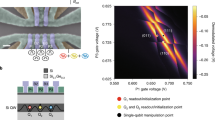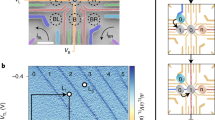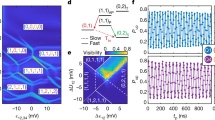Abstract
Spin qubits involving individual spins in single quantum dots or coupled spins in double quantum dots have emerged as potential building blocks for quantum information processing applications1,2,3,4. It has been suggested that triple quantum dots may provide additional tools and functionalities. These include encoding information either to obtain protection from decoherence or to permit all-electrical operation5, efficient spin busing across a quantum circuit6, and to enable quantum error correction using the three-spin Greenberger-Horn-Zeilinger quantum state. Towards these goals we demonstrate coherent manipulation of two interacting three-spin states. We employ the Landau–Zener–Stückelberg7,8 approach for creating and manipulating coherent superpositions of quantum states9. We confirm that we are able to maintain coherence when decreasing the exchange coupling of one spin with another while simultaneously increasing its coupling with the third. Such control of pairwise exchange is a requirement of most spin qubit architectures10, but has not been previously demonstrated.
This is a preview of subscription content, access via your institution
Access options
Subscribe to this journal
Receive 12 print issues and online access
$259.00 per year
only $21.58 per issue
Buy this article
- Purchase on SpringerLink
- Instant access to full article PDF
Prices may be subject to local taxes which are calculated during checkout




Similar content being viewed by others
References
Petta, J. R. et al. Coherent manipulation of coupled electron spins in semiconductor quantum dots. Science 309, 2180–2184 (2005).
Koppens, F. H. L. et al. Driven coherent oscillations of a single electron spin in a quantum dot. Nature 442, 766–771 (2006).
Hanson, R., Kouwenhoven, L. P., Petta, J. R., Tarucha, S. & Vandersypen, L. M. K. Spins in few-electron quantum dots. Rev. Mod. Phys. 79, 1217–1265 (2007).
Pioro-Ladrière, M. et al. Electrically driven single-electron spin resonance in a slanting Zeeman field. Nature Phys. 4, 776–779 (2008).
DiVincenzo, D. P., Bacon, D., Kempe, J., Burkard, G & Whaley, K. B. Universal quantum computation with the exchange interaction. Nature 408, 339–342 (2000).
Greentree, A. D., Cole, J. H., Hamilton, A. R. & Hollenberg, L. C. L. Coherent electronic transfer in quantum dot systems using adiabatic passage. Phys. Rev. B 70, 235317 (2004).
Shevchenko, S., Ashhab, S. & Nori, F. Landau–Zener–Stückelberg interferometry. Phys. Rep. 492, 1–30 (2010).
Zener, C. Non-adiabatic crossing of energy levels. Proc. R. Soc. Lond. A 137, 696–702 (1932).
Petta, J. R., Lu, H. & Gossard, A. C. A coherent beam splitter for electronic spin states. Science 327, 669–672 (2010).
Loss, D. & DiVincenzo, D. P. Quantum computation with quantum dots. Phys. Rev. A 57, 120–126 (1998).
Ciorga, M. et al. Addition spectrum of a lateral dot from Coulomb and spin-blockade spectroscopy. Phys. Rev. B 61, R16315–R16318 (2000).
Elzermann, J. et al. Few-electron quantum dot circuit with integrated charge read out. Phys. Rev. B 67, 161308(R) (2003).
Field, M. et al. Measurements of Coulomb blockade with a noninvasive voltage probe. Phys. Rev. Lett. 70, 1311–1314 (1993).
Laird, E. A. et al. Coherent spin manipulation in an exchange-only qubit. Phys. Rev. B 82, 075403 (2010).
Granger, G. et al. Three-dimensional transport diagram of a triple quantum dot. Phys. Rev. B 82, 075304 (2010).
Taylor, J. M. et al. Relaxation, dephasing, and quantum control of electron spins in double quantum dots. Phys. Rev. B 76, 035315 (2007).
Ono, K., Austing, D. G., Tokura, Y. & Tarucha, S. Current rectification by Pauli exclusion in a weakly coupled double quantum dot system. Science 297, 1313–1317 (2002).
Ribeiro, H., Petta, J. R. & Burkard, G. Harnessing the GaAs quantum dot nuclear spin bath for quantum control. Phys. Rev. B 82, 115445 (2010).
Särkkä, J. & Harju, A. Spin dynamics at the singlet–triplet crossings in a double quantum dot. New J. Phys. 13, 043010 (2011).
Brataas, A. & Rashba, E. Nuclear dynamics during Landau–Zener singlet–triplet transitions in double quantum dots. Phys. Rev. B 84, 045301 (2011).
Baugh, J. et al. Solid-state NMR three-qubit homonuclear system for quantum-information processing: Control and characterization. Phys. Rev. A 73, 022305 (2006).
Acknowledgements
We thank D. G. Austing, W. Coish and E. Laird for discussions and O. Kodra for programming. A.S.S. and M.P-L. acknowledge funding from NSERC. G.G., A.K, M.P-L., and A.S.S. acknowledge funding from CIFAR. G.G. acknowledges funding from the NRC-CNRS collaboration.
Author information
Authors and Affiliations
Contributions
Z.R.W. developed and grew the 2DEG heterostructure free of telegraphic noise; A.K. fabricated the triple quantum dot device capable of reaching the few-electron regime; P.Z., L.G. and S.A.S. designed and built the high-frequency lines up to 50 GHz at millikelvin temperatures; P.Z., L.G. and G.G. ran the cryogenic equipment; L.G., G.G., S.A.S. and M.P-L. developed the pulsing techniques; G.G., L.G. and S.A.S. performed the measurements; G.G., L.G. and G.C.A. analysed the data; G.C.A. performed theoretical simulations; G.G. and A.S.S. wrote the manuscript and Supplementary Information with input from all authors; G.G., L.G. and G.C.A made the figures; G.G., L.G., G.C.A., S.A.S., M.P-L. and A.S.S. participated in discussions concerning the experimental and theoretical results; and A.S.S. supervised the project.
Corresponding author
Ethics declarations
Competing interests
The authors declare no competing financial interests.
Supplementary information
Supplementary Information
Supplementary Information (PDF 975 kb)
Rights and permissions
About this article
Cite this article
Gaudreau, L., Granger, G., Kam, A. et al. Coherent control of three-spin states in a triple quantum dot. Nature Phys 8, 54–58 (2012). https://doi.org/10.1038/nphys2149
Received:
Accepted:
Published:
Issue date:
DOI: https://doi.org/10.1038/nphys2149
This article is cited by
-
Coherent charge oscillations in a bilayer graphene double quantum dot
Nature Communications (2023)
-
Virtual-photon-mediated spin-qubit–transmon coupling
Nature Communications (2019)
-
Spin-Polarized Transport and Spin Seebeck Effect in Triple Quantum Dots with Spin-Dependent Interdot Couplings
Nanoscale Research Letters (2018)
-
Landau-Zener-Stückelberg interference in coherent charge oscillations of a one-electron double quantum dot
Scientific Reports (2018)
-
Coherent transfer of electron spin correlations assisted by dephasing noise
Nature Communications (2018)



